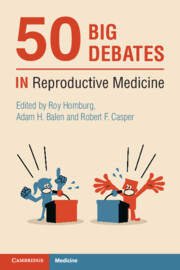Book contents
- 50 Big Debates in Reproductive Medicine
- Series page
- 50 Big Debates in Reproductive Medicine
- Copyright page
- Contents
- Contributors
- Foreword
- Introduction
- Section I Limits for IVF
- Section II IVF Add-ons
- Section III The Best Policy
- Section IV Embryology
- Section V Ethics and Statistics
- Section VI Male-factor Infertility
- 35A Sperm Counts Are Falling Worldwide
- 35B Sperm Counts Are Falling Worldwide
- 36A There Is Value in Examining Sperm DNA Fragmentation
- 36B There Is Value in Examining Sperm DNA Fragmentation
- 37A Testicular Sperm Should Be Considered for Repeated ICSI Failed Implantation Cases in Men with High Sperm DNA Damage
- 37B Testicular Sperm Should Be Considered for Repeated ICSI Failed Implantation Cases in Men with High DNA Damage
- Section VII Genetics
- Section VIII Ovarian Stimulation
- Section IX Hormones and the Environment
- Index
- References
37B - Testicular Sperm Should Be Considered for Repeated ICSI Failed Implantation Cases in Men with High DNA Damage
Against
from Section VI - Male-factor Infertility
Published online by Cambridge University Press: 25 November 2021
- 50 Big Debates in Reproductive Medicine
- Series page
- 50 Big Debates in Reproductive Medicine
- Copyright page
- Contents
- Contributors
- Foreword
- Introduction
- Section I Limits for IVF
- Section II IVF Add-ons
- Section III The Best Policy
- Section IV Embryology
- Section V Ethics and Statistics
- Section VI Male-factor Infertility
- 35A Sperm Counts Are Falling Worldwide
- 35B Sperm Counts Are Falling Worldwide
- 36A There Is Value in Examining Sperm DNA Fragmentation
- 36B There Is Value in Examining Sperm DNA Fragmentation
- 37A Testicular Sperm Should Be Considered for Repeated ICSI Failed Implantation Cases in Men with High Sperm DNA Damage
- 37B Testicular Sperm Should Be Considered for Repeated ICSI Failed Implantation Cases in Men with High DNA Damage
- Section VII Genetics
- Section VIII Ovarian Stimulation
- Section IX Hormones and the Environment
- Index
- References
Summary
Utilising ejaculated sperm with an elevated sperm DNA fragmentation (SDF) has been found to result in poor ICSI outcomes. Ejaculated sperm from the epididymis is more prone to DNA damage, due to the oxidative stress associated with epididymal transit as described by Esteves et al. [1], who found a DNA fragmentation index (DFI) of 8.3% in testicular sperm versus 40.7% in ejaculated sperm. Similar findings were reported by Greco et al. With this knowledge many clinicians are increasingly inclined to perform ICSI with testicular sperm in patients with failed implantation and high levels of DNA damage. However, no randomised controlled trials have documented the benefit of using testicular compared to ejaculated sperm [2]. In contrast, despite the lower SDF in testicular sperm, Moskovtsev et al. showed that testicular sperm have 2-3-fold higher aneuploidy rates than ejaculated samples. These results have been contested, though, in a recent study in which the rates of aneuploidy in testicular sperm were not higher than ejaculated sperm. Yet, it is important to recognise that the studies concerning aneuploidy have small samples and are inconclusive.
- Type
- Chapter
- Information
- 50 Big Debates in Reproductive Medicine , pp. 191 - 193Publisher: Cambridge University PressPrint publication year: 2021

